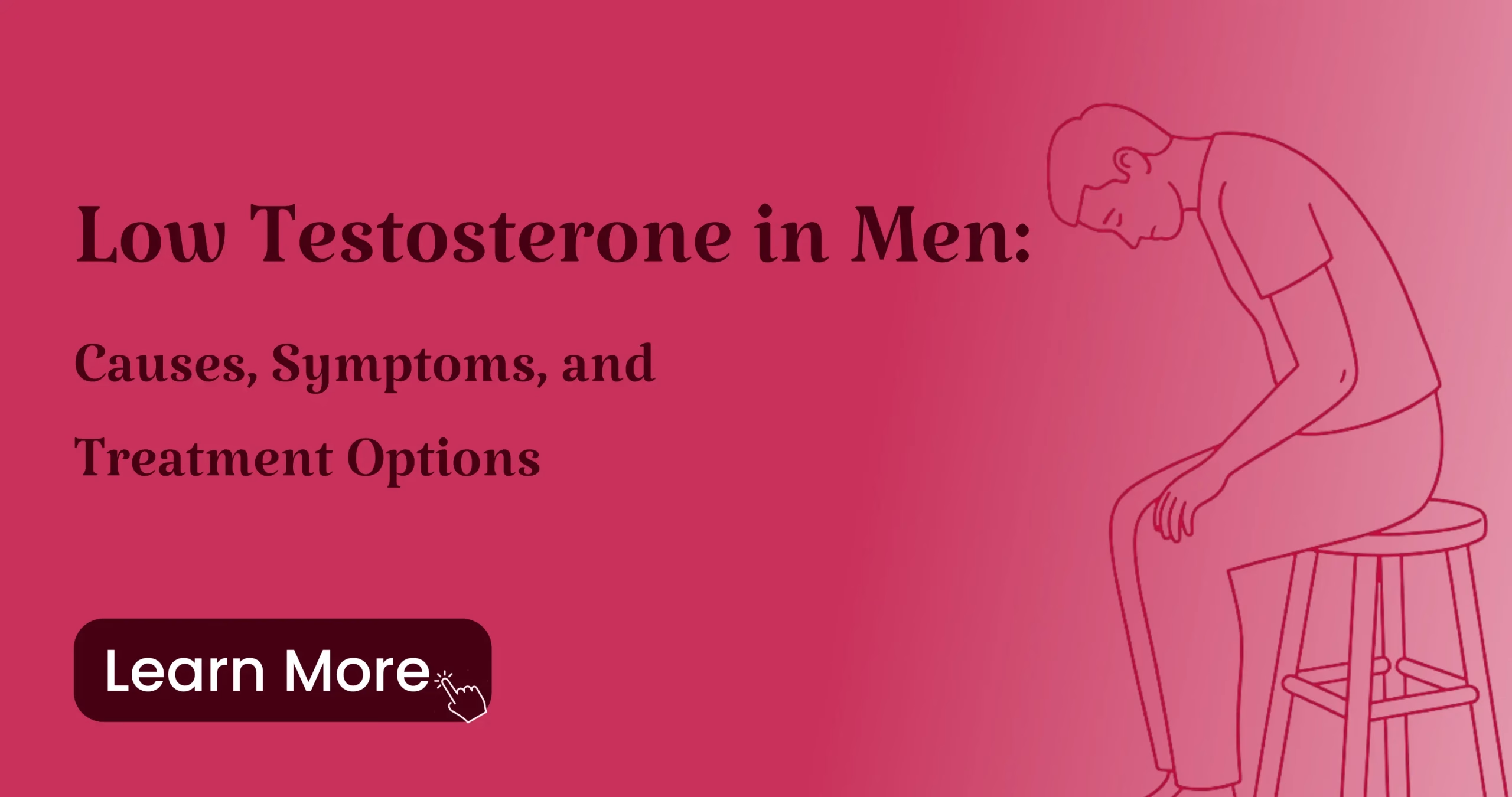Testosterone is the primary male sex hormone produced mainly by the testicles. It plays a crucial role during puberty by developing male physical characteristics such as a deeper voice, facial and body hair growth, increased muscle mass, and overall strength. Beyond sexual development, testosterone is essential for sex drive (libido), bone density, fat distribution, red blood cell production, and sperm formation.
Testosterone levels typically peak during late adolescence and early adulthood but naturally decline after the age of 30–40. While this gradual drop is part of aging, many men experience abnormally low levels due to other underlying causes, known as low testosterone or male hypogonadism.
If left untreated, low testosterone can lead to serious complications such as osteoporosis, heart disease, infertility, and reduced quality of life. Early diagnosis and treatment can help restore healthy hormone levels and prevent long-term issues.
Common Symptoms of Low Testosterone in Men
Low testosterone symptoms vary depending on age, severity, and underlying causes. Some of the most reported signs include:
- Reduced sex drive (low libido)
- Erectile dysfunction (ED)
- Fatigue or constant tiredness
- Decreased muscle mass and strength
- Loss of bone density (osteoporosis risk)
- Increased body fat or weight gain
- Difficulty concentrating or memory problems
- Reduced facial and body hair growth
- Smaller testicular size
- Enlarged breast tissue (gynecomastia)
- Low semen volume
- Infertility issues
- Mood swings, irritability, or depression
- Trouble sleeping (insomnia)
If these symptoms persist, consult a healthcare professional. In some cases, testosterone replacement therapy (TRT) may be recommended to restore normal hormone levels.
Learn more: Erectile Dysfunction Causes & Treatments – A Complete Guide for Men
Major Causes of Low Testosterone in Men
Low testosterone affects nearly 40% of men over 45, but it can also occur at younger ages due to a variety of factors:
1. Aging
Natural testosterone decline begins around age 30–40 and continues gradually. This can lead to reduced libido, muscle loss, and lower bone density. While aging cannot be stopped, healthy lifestyle habits can help slow the decline.
2. Genetic Disorders
Conditions like Klinefelter syndrome and Kallmann syndrome affect testicular development or hormone regulation, leading to reduced testosterone production.
3. Physical Trauma
Injury to both testicles can disrupt blood supply and hormone production, resulting in primary hypogonadism.
4. Infections
Illnesses such as mumps orchitis can cause long-term testicular damage. Other infections, including tuberculosis and HIV, may impair testosterone production.
5. Medication Side Effects
Certain drugs—such as opioids, chemotherapy agents, prostate cancer treatments, anabolic steroids, and some cholesterol-lowering statins—can lower testosterone levels.
6. Medical Treatments
Chemotherapy, radiation therapy, or certain surgeries can damage testicular function. If testosterone levels drop below 300 ng/dL, TRT may be considered under medical supervision.
also read: Best medicine for erectile dysfunction without side effects
Treatment and Prevention
If diagnosed with low testosterone, treatment will depend on the underlying cause. Options include:
- Testosterone Replacement Therapy (TRT) – Available as gels, injections, patches, or capsules
- Lifestyle Changes – Regular exercise, a nutrient-rich diet, quality sleep, and stress management
- Managing Chronic Illnesses – Controlling conditions like diabetes or obesity that can affect hormone levels
- Avoiding Substance Abuse – Limiting alcohol, avoiding smoking, and steering clear of anabolic steroid misuse
Key Takeaway
Low testosterone in men can impact physical health, sexual performance, and emotional well-being. Recognizing the early signs and addressing the root causes—whether through lifestyle changes or medical treatments—can help maintain optimal health and quality of life. Always consult a qualified healthcare provider before starting any hormone therapy to ensure safety and effectiveness.
Bottom Line
While low testosterone is not typically a life-threatening condition, its symptoms can greatly impact a man’s quality of life, affecting energy levels, sexual health, mood, and overall well-being.
If you suspect you have low testosterone, it’s important to consult a qualified healthcare professional to identify the exact cause and determine whether immediate treatment is necessary. Common treatment options include testosterone replacement therapy (TRT), topical gels like Cernos Gel, oral supplements such as Cernos Soft Gelatin, and in some cases, surgical interventions.
Your doctor will recommend the most effective and safe approach based on your individual health needs and underlying conditions. All treatment plans for low testosterone in men should be carried out under professional medical supervision to ensure safety and optimal results.
Before starting therapy, be aware of the potential side effects and risks, and discuss them thoroughly with your doctor. Taking informed steps can help restore hormone balance, improve daily functioning, and reduce the risk of future health complications.
Explore more: Common Male Sexual Disorders: What is Sexual Problems?
FAQS
1. What is considered low testosterone in men?
Low testosterone, also called male hypogonadism, is typically diagnosed when testosterone levels fall below 300 nanograms per deciliter (ng/dL) of blood. A blood test is required to confirm the diagnosis.
2. What causes low testosterone in men?
Causes include aging, genetic disorders (such as Klinefelter syndrome), testicular injury, infections like mumps orchitis, certain medications (opioids, chemotherapy drugs, anabolic steroids), and chronic illnesses like diabetes or obesity.
3. What are the symptoms of low testosterone?
Common symptoms include low sex drive, erectile dysfunction, fatigue, loss of muscle mass, weight gain, mood changes, reduced bone density, hair loss, and infertility.
4. How is low testosterone treated?
Treatment options include testosterone replacement therapy (TRT) in the form of gels, injections, patches, or capsules, as well as lifestyle changes like exercise, a balanced diet, better sleep, and managing chronic conditions.
5. Can low testosterone be cured naturally?
Some cases can be improved naturally by losing weight, building muscle through resistance training, reducing stress, improving sleep quality, and eating a nutrient-rich diet. However, severe cases may require medical intervention.
6. Is testosterone replacement therapy safe?
TRT can be safe when prescribed and monitored by a doctor, but it may carry risks such as acne, fluid retention, increased red blood cell count, and potential heart or prostate issues. Regular follow-ups are essential.
7. Can low testosterone affect mental health?
Yes. Low testosterone can lead to depression, irritability, difficulty concentrating, and memory problems. Addressing hormone imbalance can often improve mood and cognitive function.
For More Details Visit: clevelandclinic.org, healthline.com, medlineplus.gov
Disclaimer: This article is for informational purposes only. Consult a healthcare provider before using any medication.





